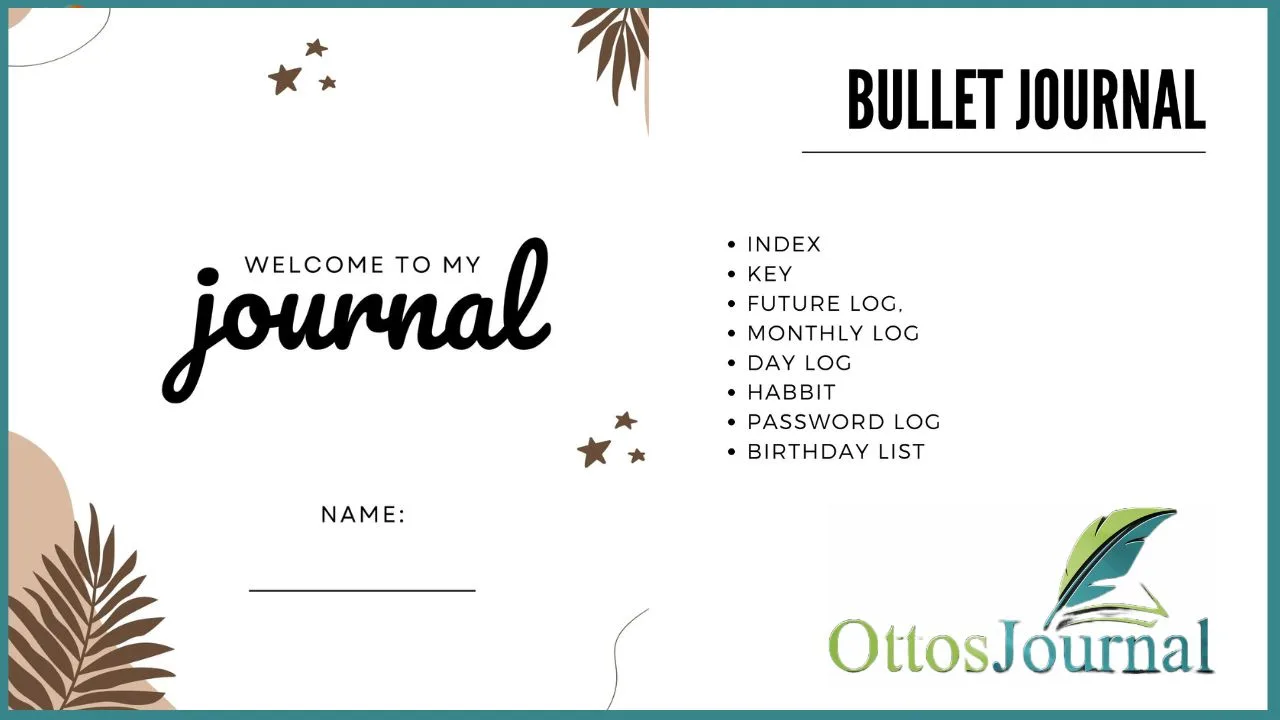Bullet journaling is a popular way to organize your life and keep track of tasks, goals, projects, and more. But going minimalist can be difficult if you are used to having lots of bells and whistles. In this article, I will provide you with tips on how to stick with a minimalist bullet journal and provide you minimalist bullet journal ideas to help you get started.
How to Stick With a Minimalist Bullet Journal
1. Find Inspiration:
Look for inspiration from minimalist bullet journals online or in books to help keep you motivated and excited about your own journal.
2. Set Reminders:
Set regular reminders on your phone, computer, or a wall calendar to remind you to keep up with the minimalist bullet journaling process.
3. Experiment with Layout Ideas:
Try out different simple bullet journal layout ideas for your journal to keep things fresh and interesting.
4. Change Writing Instruments:
If you’ve been using the same pen or pencil, switch it up with a new one from time to time. This can help make bullet journaling more enjoyable and give it some variety.
5. Create Monthly Challenges:
Set a monthly challenge for yourself such as a monthly theme, spread ideas, or a certain number of pages to fill.
6. Take Notes Outside the Journal:
If you’re feeling overwhelmed with all your thoughts and tasks, take notes outside the journal in order to better prioritize what goes into it.
7. Change Writing Styles:
Switch up your writing styles by trying out different fonts or writing styles to add some visual interest to the journal.
8. Track Progress:
Track your progress by making notes about how your bullet journaling is going and what you need to work on in order to make it better.
9. Use a Variety of Colors:
Even with minimalist bullet journals, you can still use a variety of colors when organizing your entries. This will help you easily identify tasks or categories without overwhelming the page.
10. Get Creative:
Incorporate creative elements into your minimalist bullet journal spreads such as sketches, doodles, photos, or quotes to make it more personal and enjoyable.
11. Try New Spreads:
Experiment with different spreads that could work for your minimalist bullet journal, such as a monthly tracker, habit tracker, or goal list.
12. Make It Visible:
Place your bullet journal in an area where you can easily see it. This will help keep you motivated to work on it and stick with the minimalist approach.
13. Declutter Regularly:
Take time to declutter your bullet journal of any unnecessary notes or entries that are no longer relevant.
14. Follow a Theme:
Pick out a theme for your bullet journal such as productivity, gratitude, health & wellness, etc. This will give you something to focus on and help keep your entries organized.
15. Showcase Your Work:
Share your work with others through social media or by creating video tutorials of how you use your minimalist bullet journal. This can be a great way to connect with fellow bullet journalists and get inspired!
How to Start Your Very Own Minimalist Bullet Journal
Pick Your Notebook
Select a notebook with minimal designs or a plain black-and-white journal to get started. This will mean that there is less visual clutter in the pages, allowing you to focus more on the actual content of your minimal bullet journal spread without being distracted by too much artwork or design elements.
Choose Your Writing Tool
A simple pen or pencil will do the trick. You don’t need to invest in fancy pens or markers to get started with your minimalist bullet journal.
Utilize Color Sparingly
Use colors sparingly when creating your layout and writing tasks and goals into it. Colors can be useful for categorizing information, but too much of it can be distracting and overwhelm you.
Make Lists
Bullet journals are great for making lists, such as your to-do list, grocery list, tasks for the day, or goals for the month and year. Keeping your ideas in a neat and organized way will help you stay on top of everything without getting overwhelmed.
Use Icons
Icons are a great way to quickly and easily identify tasks or categories. You can use icons such as check marks, arrows, or exclamation points to better organize your entries.
Create Simple Spreads
Keep things simple by creating basic spreads that are easy to look at and understand. This could be monthly calendars, weekly goals, task lists, etc. Avoid creating spreads that are overly complicated and have too much information on them.
Keep It Clean
Don’t overstuff your pages with too many entries, decorations, or colors. The minimalist approach is all about simplicity and making sure there’s enough space to write everything down without cluttering the page.
Take Breaks
Taking breaks from bullet journaling is important to keep your creativity and motivation alive. Taking some time away from it will help you come back with fresh ideas and a new outlook on how to make your bullet journal even better.
Have Fun
Don’t forget that the main purpose of a bullet journal is to be fun! You can add decorations, change up the layout, or try out different writing instruments. Find what works best for you and have fun with it!
Pros and Cons of Minimalist Bullet Journal
Pros:
Allows for more focus
Having a minimalist journal helps you stay focused on the task at hand. With less distractions and visual clutter, it is easier to keep on track with your goals and objectives.
Utilizes fewer resources
By having a minimalist approach to bullet journaling, there is less need for extra paper, markers, and other minimalist bullet journal supplies. This saves you money in the long run and reduces your overall environmental impact.
Easier to maintain
Keeping a minimalist bullet journal system is much easier to maintain than one filled with lots of decorative elements or doodles. This makes it easier to keep track of tasks and make changes when needed.
Saves time
Having minimalist bullet journal pages saves time as you don’t have to spend too much time organizing or decorating the pages. This means you have more time to focus on important tasks or goals.
Cheaper
As a minimalist bullet journal notebook requires fewer supplies and decorations, it is cheaper than having an elaborate one.
Cons:
Less creative
It can be easy to feel uninspired when your bullet journal is plain and minimalist. This lack of creativity can lead you to not want to use your bullet journal at all, defeating the purpose of having one in the first place.
Overlook important details
With fewer visual elements, it might be easier to overlook important details when writing down tasks and goals in your journal.
Difficult to stay organized
It can be more difficult to keep track of tasks and deadlines with a minimalist bullet journal as there are fewer visual indicators such as color coding or icons.
Can be too simple
Having a minimalist bullet journal key page means that there isn’t a lot of room for extra details. This can be limiting and make it difficult to really express how you feel about a certain task or goal.
Less visually appealing
If you’re used to having a more decorative bullet journal, you might find the minimalist version to be too plain and boring. This could make it hard to stay motivated to keep up with your bullet journaling.
Tips for Organized Minimalist Bullet Journal
Set Up a System
You need to come up with a system that works best for you and your bullet journal. This can include setting up categories, color code sections, or having daily or weekly goals in your minimalist bullet journal weekly spread.
Create Pages Ahead of Time
Get ahead by creating pages before they are needed in order to save time and energy later on. This can also help ensure that you have everything ready for when you are actually bullet journaling.
Use Icons
Utilize small icons to help keep track of tasks and events in your minimalist bullet journal. This will make it easier to quickly glance over the page and know what needs to be done without having to read through everything.
Streamline Your Lists
Make your lists more streamlined by adding checkboxes or other indicators to show what tasks have been completed. This will help you stay on track and avoid any confusion later on.
Schedule Flexible Pages
Have pages that are flexible so that you can move things around if needed without having to start all over again. This will give you more freedom when it comes to rearranging or adding tasks.
Use Note Cards
Keep note cards with daily checklists, goals, and other notes that can be easily shuffled around in your minimalist bullet journal. This will help make sure everything is organized while still allowing for some flexibility in the pages.
Be Consistent
Make sure to be consistent with your bullet journaling and track your progress regularly. This helps ensure that you are staying on top of tasks and meeting deadlines without putting too much pressure on yourself.
Bottom Line
A minimalist bullet journal is a great way to keep organized and stay on top of tasks. It takes some practice and experimentation to figure out the best system for your needs, but it’s worth it in the end.
By creating pages ahead of time, using icons, and being consistent with your tracking, you can make sure that your minimalist bullet journaling is always effective.





